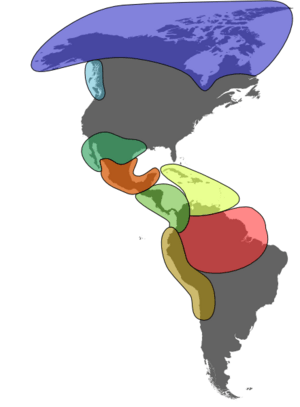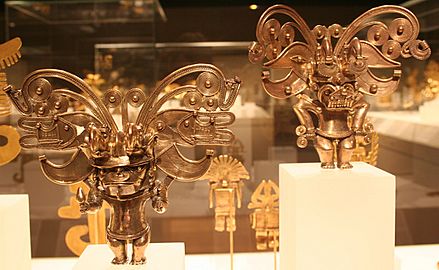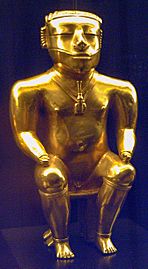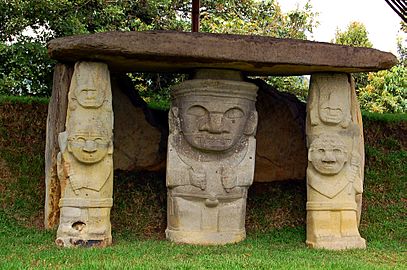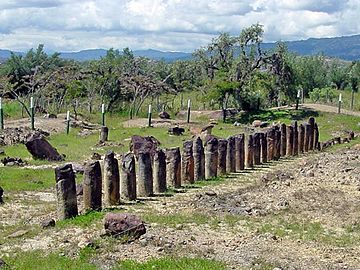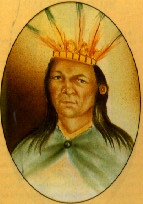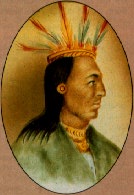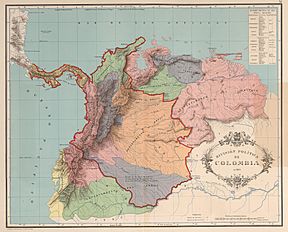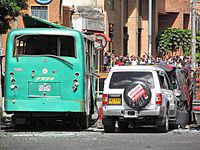History of Colombia facts for kids
The history of Colombia is a fascinating story of people, cultures, and big changes. It starts with amazing native groups like the Muisca Confederation, Quimbaya, and Tairona. Then, in 1492, the Spanish arrived and began to take over and settle the land. They created a large area called the Viceroyalty of New Granada, with its main city in Bogotá.
Colombia gained its freedom from Spain in 1819. For a short time, it was part of a big country called "Gran Colombia", but this group broke apart by 1830. What we now know as Colombia and Panama became the Republic of New Granada. The new nation tried different ways of governing, like the Granadine Confederation (in 1858) and the United States of Colombia (in 1863). Finally, in 1886, it became the Republic of Colombia. Panama separated in 1903.
Since the 1960s, Colombia has faced an internal conflict, which became more intense in the 1990s but has lessened since 2005. All these historical events have created a rich culture. Also, Colombia's varied geography and impressive landscape have led to strong local identities across the country.
Contents
- Ancient Times: Before Europeans Arrived
- Spanish Explorers Arrive
- Colombia Becomes Independent
- Building a New Nation: Conflicts and Changes
- Working Together: The National Front (1958–1974)
- Challenges and Peace Efforts
- A New Constitution and Ongoing Peace Talks
- Colombia Today: Peace and New Leaders
- See also
Ancient Times: Before Europeans Arrived
About 12,000 years ago, groups of hunter-gatherers lived near where Bogotá is today. They traded with each other and with people in the Magdalena River valley. Colombia's location was like a bridge for early humans moving from Mesoamerica (Central America) and the Caribbean to the Andes mountains and the Amazon basin.
The oldest signs of human life are from sites in the Magdalena Valley, about 100 kilometers (62 miles) southwest of Bogotá. These date back to a very early period (18,000–8000 BCE). Even older pottery, the oldest found in the Americas, has been discovered at a site called San Jacinto, dating from 5000–4000 BCE.
A mountainous area called Serranía La Lindosa in the Guaviare Department has an amazing prehistoric rock art site. It stretches for almost eight miles! This site was found in 2019 but revealed to the public in 2020. There are tens of thousands of paintings of animals and humans, made up to 12,500 years ago. Pictures of animals from the Ice Age, like the mastodon (an ancient elephant-like animal), helped scientists figure out how old the site is. Other Ice Age animals shown include giant sloths and ancient horses.
Between 5000 and 1000 BCE, hunter-gatherer groups started to become farming societies. They built permanent homes, and pottery began to appear. Starting around 1000 BCE, groups like the Muisca, Quimbaya, Tairona, and others became very skilled in farming, mining, and working with metals. Some also developed complex political systems led by chiefs called caciques.
The Muisca lived mainly in the high plains of what are now the departments of Boyacá and Cundinamarca. They formed the Muisca Confederation, which had one of the most advanced political systems in South America, second only to the Incas. They grew corn, potatoes, quinoa, and cotton. They traded gold, emeralds, blankets, pottery, and especially salt with nearby groups. The Tairona lived in northern Colombia, in the isolated Sierra Nevada de Santa Marta mountains. The Quimbaya lived in the Cauca River Valley. The Incas also expanded their empire into the southwest part of the country.
- Pre-Columbian
-
The zipa (a Muisca ruler) would cover his body in gold and offer treasures to a goddess in a sacred lake. This tradition led to the El Dorado legend.
-
A gold bird ornament from the lowland Zenú culture, made around 490 CE.
-
Tairona pendants made of gold.
-
A golden statue of a Quimbaya cacique (chief).
-
San Agustín Archaeological Park is a UNESCO World Heritage Site with many ancient religious monuments and sculptures.
-
Ciudad Perdida (Lost City) was founded around 800 CE. It has 169 terraces and stone roads.
-
El Infiernito is an ancient site near Villa de Leyva used for studying the stars.
Spanish Explorers Arrive
Europeans first came to what is now Colombia in 1499 with an expedition led by Alonso de Ojeda. The Spanish tried to settle along the northern coast in the early 1500s. Their first lasting settlement was at Santa Marta in 1525. Pedro de Heredia founded Cartagena on June 1, 1533, where an indigenous village used to be. Cartagena quickly grew rich, first from gold found in ancient tombs and later from trade.
The desire for gold and land drew Spanish explorers inland to areas where Chibchan languages were spoken. This led to the Spanish conquest of the Chibchan Nations, where the Spanish took over the lands of the Muisca and Tairona peoples. This marked the beginning of the Spanish colonization of the Americas.
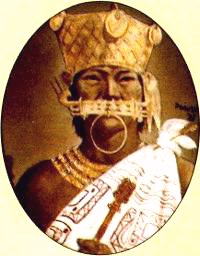
The Spanish moved inland from the Caribbean coast from three different directions. The leaders were Jimenéz de Quesáda, Sebastián de Benalcázar, and Nikolaus Federmann. Even though they were all looking for treasures, none of them planned to meet in Muisca territory, but they did. In August 1538, Quesáda founded Santa Fe de Bogotá on the site of a Muisca village called Bacatá.
In 1549, the Spanish Royal Court (called the Audiencia) was set up in Bogotá. This made Bogotá the capital of New Granada, which covered much of what is now Colombia. Even in the 1500s, some people in Colombia were unhappy with Spanish rules. Spain did not allow direct trade between its colonies in Peru (which included Colombia) and New Spain (which included the Philippines). This meant that valuable Asian goods like silk and porcelain were hard to get. However, people secretly traded these goods, and smuggled Asian products ended up in Córdoba, Colombia, becoming a center for illegal imports. This showed early signs of people going against Spanish authority.
In 1717, the Viceroyalty of New Granada was first created. It was temporarily removed and then brought back in 1739. Bogotá became its capital. This Viceroyalty included parts of what are now Venezuela, Ecuador, and Panama. So, Bogotá became one of the most important administrative centers for Spain in the New World, along with Lima and Mexico City.
Colombia Becomes Independent
The long fight for independence was mainly led by Bolívar and Francisco de Paula Santander from Venezuela. Bolívar came back to New Granada in 1819 after becoming a leader of the independence fighters in Venezuela. He led an army over the Andes mountains and took control of New Granada after a quick campaign that ended with the Battle of Boyacá on August 7, 1819.
In that same year, the Congress of Angostura created the Republic of Gran Colombia. This new country included all the lands that were part of the old Viceroyalty of New Granada. Bolívar was chosen as the first president of Gran Colombia, and Santander became the vice president.
However, the Federation of Gran Colombia broke apart in 1830. The area that was the Department of Cundinamarca then became a new country, the Republic of New Granada.
Building a New Nation: Conflicts and Changes
In 1863, the country's name officially changed to "United States of Colombia". Then, in 1886, it adopted its current name: "Republic of Colombia".
Two main political parties grew from the disagreements between Bolívar's and Santander's followers: the Conservatives and the Liberals. These parties have been very important in Colombian politics ever since. Bolívar's supporters, who later became the Conservatives, wanted a strong central government, a close relationship with the Roman Catholic Church, and limited voting rights. Santander's followers, who became the Liberals, wanted a government with less central power, for the state to control education instead of the church, and more people to have the right to vote.
Throughout the 1800s and early 1900s, each party held the presidency for about the same amount of time. Colombia usually had a civilian government and regular, free elections. The military only took power three times: in 1830 (after Gran Colombia broke up), in 1854 (by General José María Melo), and from 1953 to 1957 (under General Gustavo Rojas Pinilla). Civilian rule returned quickly in the first two cases.
Despite its commitment to democracy, Colombia's history has also seen widespread, violent conflicts. Two civil wars happened because of the strong rivalry between the Conservative and Liberal parties. The Thousand Days' War (1899–1902) caused an estimated 100,000 deaths. Up to 300,000 people died during "La Violencia" in the late 1940s and 1950s. This was a conflict between the two parties that started after the popular Liberal candidate Jorge Eliécer Gaitán was killed.
The United States also became involved in the area, especially with the building and control of the Panama Canal. This led to a military uprising in Panama in 1903, which resulted in Panama separating and becoming an independent country.
In 1953, a military takeover removed the Conservative government of Laureano Gómez and brought General Gustavo Rojas Pinilla to power. At first, Rojas was very popular because he helped reduce "La Violencia". However, when he didn't bring back democratic rule and sometimes used harsh methods, the military removed him in 1957 with support from both political parties. A temporary government was then put in place.
Working Together: The National Front (1958–1974)
In July 1957, former Conservative President Laureano Gómez and former Liberal President Alberto Lleras Camargo suggested a "National Front." This was an agreement where the Liberal and Conservative parties would govern together. The presidency would switch between a Conservative and a Liberal president every four years for 16 years. Both parties would also have an equal number of positions in other elected offices.
The National Front helped end "La Violencia". The governments during this time tried to make big social and economic changes. For example, Liberal president Alberto Lleras Camargo (1958–1962) created the Colombian Institute for Agrarian Reform (INCORA), which helped give land titles to farmers.
However, the results were mixed because of disagreements between the Liberal and Conservative leaders. Many social and political problems continued. Over time, the National Front system itself started to be seen as a way of limiting political choices. This was especially true after the 1970 election, which many believed was unfair. The M-19 guerrilla group was formed partly because of this event. The FARC was created in 1964 by Manuel Marulanda Vélez and others after a military attack on a community called Marquetalia.
Even though the National Front system officially ended by 1974, the Colombian constitution at the time (from 1886) required the losing political party to have a fair share in the government. This sometimes led to more corruption. The current constitution from 1991 does not have this rule, but later governments have still often included members from different parties.
Challenges and Peace Efforts
From 1974 to 1982, different presidents focused on trying to stop the ongoing armed groups that wanted to change Colombia's political system. These groups claimed to represent the poor and weak against the rich and powerful, demanding real land and political reforms.
By 1974, another challenge came from the 19th of April Movement (M-19). This was mostly an urban guerrilla group formed because of the suspected unfair election in 1970. At first, the M-19 got some attention and sympathy from many Colombians because of their bold actions, like stealing a sword that belonged to Colombia's independence hero, Simon Bolívar. However, their high profile also made them a main target for the government's efforts to stop them.
The ELN guerrilla group had been weakened by military actions by 1974, but it managed to rebuild itself. This was partly because the government of Alfonso López Michelsen (1974–1978) allowed them to escape, hoping to start a peace process with the group.
By 1982, the government had some success against the M-19 and ELN. This allowed President Julio César Turbay Ayala (1978–1982) to lift a special emergency decree that had been in place for much of the previous 30 years.
People were tired of the intense conflict, which led to the election of President Belisario Betancur (1982–1986). He was a Conservative who won with 47% of the votes. He reached out to all the armed groups and negotiated a cease-fire (a stop to fighting) with the FARC and M-19 in 1984. The ELN refused to negotiate and continued to grow stronger by demanding money and threatening people, especially foreign oil companies.
The first cease-fire with the M-19 ended when the group started fighting again in 1985. They claimed that the government had not fully respected the agreement. The Betancur government, in turn, questioned the M-19's actions. Meanwhile, the government continued talks with the FARC, which led to the creation of the Patriotic Union (Colombia) (UP), a legal political group.
On November 6, 1985, the M-19 attacked the Colombian Palace of Justice and took Supreme Court judges hostage. They wanted to put President Betancur on trial. In the fighting that followed when the military responded, many people died, including most of the guerrillas. Both sides blamed each other for the tragic outcome.
Some FARC members joined the UP leadership, but most of the FARC fighters did not give up their weapons or stop fighting. Tensions grew as both sides accused each other of not respecting the cease-fire. Government officials accused the FARC of continuing to recruit new fighters, kidnap people, demand money, and try to influence voters, even while the UP was involved in politics.
The government of Virgilio Barco Vargas (1986–1990) continued to deal with the difficult negotiations with the armed groups.
A New Constitution and Ongoing Peace Talks
After 1990, later governments continued to deal with the armed groups. The M-19 and several smaller groups successfully joined a peace process as the 1980s ended and the 1990s began. This led to elections for a special assembly that would write a new constitution, which took effect in 1991. The new Constitution brought many changes, aiming to be more modern, fair, democratic, and open than the old 1886 constitution.
Talks with the FARC, which had continued on and off, were temporarily stopped in 1990 under President César Gaviria (1990–1994). The Colombian Army attacked a FARC base, and the FARC responded with attacks. This showed a clear break in the difficult negotiations.
President Ernesto Samper took office in August 1994. However, a political crisis made it hard to focus on government programs, slowing down many planned reforms. The military also faced challenges against the armed groups, with several bases being taken over and many soldiers captured by the FARC.
On August 7, 1998, Andrés Pastrana became President. He was a Conservative and won the election with high voter turnout. His main goal was to find a peaceful solution to Colombia's long-standing conflict.
While early peace efforts gave hope, the Pastrana government also had to deal with high unemployment and other economic problems. The increasing severity of attacks by the FARC, ELN, and other groups, along with corruption and the rise of violent paramilitary groups like the AUC, made it difficult to solve the country's problems.
Even though the FARC and ELN agreed to participate in the peace process, they didn't clearly promise to end the conflict. The FARC stopped talks in November 2000, protesting what they called "paramilitary terrorism," but returned in February 2001. The government and ELN also continued discussions to start a formal peace process.
Colombia Today: Peace and New Leaders
By 2004, Colombia's security situation had improved somewhat, and the economy showed some positive signs. However, many of the country's other serious problems had not been fully solved. In October 2006, Uribe was re-elected by a large number of votes.
Some people believed that Uribe's policies, while reducing crime and armed group activity, focused too much on military solutions and didn't pay enough attention to social issues and human rights. They hoped his government would work harder to improve human rights and protect civilians. Uribe's supporters, however, believed that stronger military action was needed before any serious peace talks could happen. They thought that better security would allow the government to focus more on social concerns later. In February 2010, a court stopped President Uribe from seeking another re-election. Uribe left the presidency in 2010.
In 2010, Juan Manuel Santos was elected president. He was supported by former president Uribe. However, two years later, Santos surprised many by starting peace talks with the FARC in Havana. Re-elected in 2014, Santos brought back an important plan to improve infrastructure, especially national highways.
In 2015, Colombia's Congress limited the presidency to a single term, meaning a president cannot be re-elected.
Talks between the government and the FARC led to the announcement of a peace agreement. However, a public vote to approve the deal was unsuccessful. After this, the Colombian government and the FARC signed a revised peace deal in November 2016, which the Colombian congress approved. In 2016, President Santos received the 2016 Nobel Peace Prize for his efforts. The government also started a process to help and support victims of the conflict. A special court called the Special Jurisdiction of Peace was created to investigate and punish serious human rights violations during the conflict and ensure justice for victims. During his visit to Colombia, Pope Francis honored the victims of the conflict.
In May 2018, Ivan Duque, from the conservative Democratic Centre party, won the presidential election. On August 7, 2018, he became the new President of Colombia.
Colombia's relationship with Venezuela has changed a lot due to different political ideas between their governments. Colombia has offered humanitarian support like food and medicine to help with shortages in Venezuela. Colombia's Foreign Ministry has said that all efforts to solve Venezuela's crisis should be peaceful. In February 2019, Venezuelan president Nicolás Maduro cut off diplomatic relations with Colombia after Colombian President Ivan Duque helped Venezuelan opposition leaders deliver humanitarian aid to their country. Colombia recognized Venezuelan opposition leader Juan Guaido as Venezuela's rightful president. In January 2020, Colombia rejected Maduro's idea to bring back diplomatic relations.
On June 19, 2022, Gustavo Petro, a former guerrilla, won the presidential election with 50.47% of the votes. The single-term limit meant President Iván Duque could not run again. Petro became Colombia's first leftist president-elect and was sworn in on August 7, 2022.
See also
 In Spanish: Historia de Colombia para niños
In Spanish: Historia de Colombia para niños
- Economic history of Colombia
- History of the Americas
- History of Latin America
- History of South America
- List of presidents of Colombia
- Politics of Colombia
- Spanish colonization of the Americas


